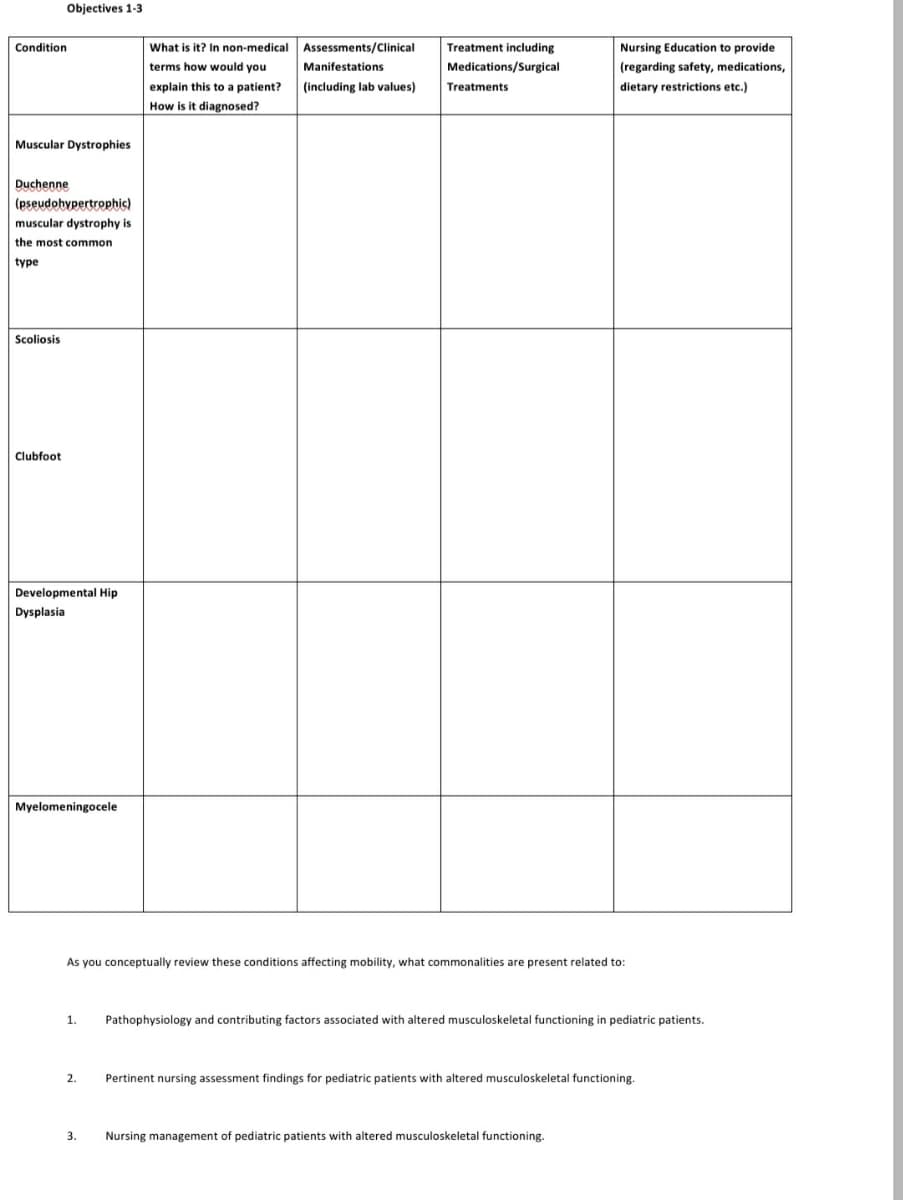Condition Objectives 1-3 Muscular Dystrophies Duchenne (pseudohypertrophic) muscular dystrophy is the most common type What is it? In non-medical terms how would you explain this to a patient? How is it diagnosed? Scoliosis Clubfoot Developmental Hip Dysplasia Myelomeningocele Assessments/Clinical Manifestations (including lab values) Treatment including Medications/Surgical Treatments Nursing Education to provide (regarding safety, medications, dietary restrictions etc.) As you conceptually review these conditions affecting mobility, what commonalities are present related to: 1. Pathophysiology and contributing factors associated with altered musculoskeletal functioning in pediatric patients. 2. Pertinent nursing assessment findings for pediatric patients with altered musculoskeletal functioning. 3. Nursing management of pediatric patients with altered musculoskeletal functioning.
Condition Objectives 1-3 Muscular Dystrophies Duchenne (pseudohypertrophic) muscular dystrophy is the most common type What is it? In non-medical terms how would you explain this to a patient? How is it diagnosed? Scoliosis Clubfoot Developmental Hip Dysplasia Myelomeningocele Assessments/Clinical Manifestations (including lab values) Treatment including Medications/Surgical Treatments Nursing Education to provide (regarding safety, medications, dietary restrictions etc.) As you conceptually review these conditions affecting mobility, what commonalities are present related to: 1. Pathophysiology and contributing factors associated with altered musculoskeletal functioning in pediatric patients. 2. Pertinent nursing assessment findings for pediatric patients with altered musculoskeletal functioning. 3. Nursing management of pediatric patients with altered musculoskeletal functioning.
Related questions
Question
Just solve accurate first fill table then answer questions full accurate dont need guideline answer ok

Transcribed Image Text:Condition
Objectives 1-3
Muscular Dystrophies
Duchenne
(pseudohypertrophic)
muscular dystrophy is
the most common
type
What is it? In non-medical
terms how would you
explain this to a patient?
How is it diagnosed?
Scoliosis
Clubfoot
Developmental Hip
Dysplasia
Myelomeningocele
Assessments/Clinical
Manifestations
(including lab values)
Treatment including
Medications/Surgical
Treatments
Nursing Education to provide
(regarding safety, medications,
dietary restrictions etc.)
As you conceptually review these conditions affecting mobility, what commonalities are present related to:
1. Pathophysiology and contributing factors associated with altered musculoskeletal functioning in pediatric patients.
2.
Pertinent nursing assessment findings for pediatric patients with altered musculoskeletal functioning.
3.
Nursing management of pediatric patients with altered musculoskeletal functioning.
Expert Solution
This question has been solved!
Explore an expertly crafted, step-by-step solution for a thorough understanding of key concepts.
Step by step
Solved in 2 steps
